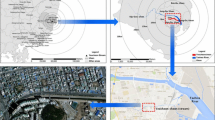Abstract
Preservation of bottomland hardwood forest wetlands is threatened by pressure from surface coal mining activities in the western Kentucky coalfield. The contingent valuation, survey method was used to measure the economic benefits (willingness-to-pay) of preserving the Clear Creek wetland, the largest wetland area in the coalfield, from surface coal mining. Results indicated that Kentucky households are willing to pay between $6 and $13, in the form of voluntary contributions to a hypothetical “Wetland Preservation Fund,” for preservation. Mine reclamation as a substitute for preservation recreational use of wetlands by survey respondents, conservation club membership, and age are determinants of willingness-to-pay. Annual aggregate benefits of Clear Creek wetland preservation are estimated to be between $2.94 million and $19 million depending on aggregation assumptions.
Similar content being viewed by others
Literature Cited
Amemiya, T. 1981. Qualitative response models: a survey. Journal of Economic Literature XIX:1493–1536.
Bowker, J.M. and J.R. Stoll. 1988. Use of dichotomous choice nonmarket methods to value the whooping crane resource. American Journal of Agricultural Economics 70:372–381.
Boyle, K.J. and R.C. Bishop. 1987. Valuing wildlife in benefit-cost analyses: a case study involving endangered species. Water Resources Research 23:943–950.
Cameron, T.A. 1988. A new paradigm for valuing non-market goods using referendum data. Journal of Environmental Economics and Management 15:355–379.
Cummings, R.G., D.S. Brookshire, and W.D. Schulze. 1986. Valuing Environmental Goods: An Assessment of the Contingent Valuation Method. Rowman and Allanheld. Totowa, NJ, USA.
Dillman, D.A. 1978. Mail and Telephone Surveys: The Total Design Method. John Wiley and Sons, New York, NY, USA.
Farber, S. 1987. The value of coastal wetlands for protection of property against hurricane wind damage. Journal of Environmentla Economics and Management 14:143–151.
Farber S. and R. Costanza. 1987. The economic value of wetlands systems. Journal of Environmental Management 24:41–51.
Hanemann, W.M. 1984. Welfare evaluation in contingent valuation experiments with discrete responses. American Journal of Agricultural Economics, 66:332–341.
Hannan, R.R., W.L. Fisher, C. Justis, and R.R. Cicerello. 1986. Wetland Protection Strategies for Kentucky. Kentucky Nature Preserves Commission, Frankfort, KY, USA.
Kentucky Department of Fish and Wildlife Resources, Illinois Department of Conservation, Indiana Department of Natural Resources, Missouri Department of Conservation, and Tennessee Wildlife Resources Agency. 1988. The New Madrid wetlands project: a component of the lower Mississippi Valley joint venture of the North American waterfowl management plan. In cooperation with U.S. Fish and Wildlife Service and other supporting agencies. Frankfort, KY, USA.
Krutilla, J.V. 1967. Conservation reconsidered. American Economic Review 57:777–784.
Leitch, J.A. 1983. Progress, problems, and prospects for successful economic evaluation of wetlands. Wetlands 3:153–160.
McConnell K.E. 1990. Models for referendum data: the structure of discrete choice models for contingent valuation. Journal of Environmental Economics and Management 18:19–34.
Mitchell, R.C. and R.T. Carson. 1989. Using Surveys to Value Public Goods: The Contingent Valuation Method. Resources for the Future, Washington, DC, USA.
Mitsch, W.J., J.R. Taylor, K.B. Benson, and P.L. Hill, Jr. 1983a. Wetlands and coal surface mining in western Kentucky—a regional impact assessment. Wetlands 3:161–179.
Mitsch, W.J., J.R. Taylor, K.B. Benson, and P.L. Hill, Jr. 1983b Atlas of Wetlands in the Principal coal Surface Mining Region of Western Kentucky. U.S. Fish and Wildlife Service, Office of Biological Services. Washington, DC, USA.
Office of Technology Assessment 1984. Wetlands: Their Use and Regulation. U.S. Congress, Washington, DC, USA.
Stoll, J.R. and J.C. Bergstrom. 1988. Contingent valuation of recreation benefits for Louisiana coastal wetlands: implications for valuing changes in a wetland area. Natural Resources Working Paper Series, Department of Agricultural Economics, Texas A&M University, College Station, TX, USA.
Sudman, S. 1976. Applied Sampling. Academic Press, New York, NY, USA.
U.S. Department of the Interior, Fish and Wildlife Service and U.S. Department of Commerce, Bureau of the Census. 1982. 1980 National Survey of Fishing, Hunting, and Wildlife-Associated Recreation. Washington, DC, USA.
University of Kentucky, Center for Business and Economic Research, 1988. Kentucky Statistical Abstract. Lexington, KY, USA.
Whitehead, J.C. 1989. The effect of substitutes on existence value and nature preservation in benefit cost analysis. Ph.D. Dissertation. University of Kentucky, Lexington, KY, USA.
Author information
Authors and Affiliations
Rights and permissions
About this article
Cite this article
Whitehead, J.C. Measuring willingness-to-pay for wetlands preservation with the contingent valuation method. Wetlands 10, 187–201 (1990). https://doi.org/10.1007/BF03160832
Received:
Issue Date:
DOI: https://doi.org/10.1007/BF03160832




